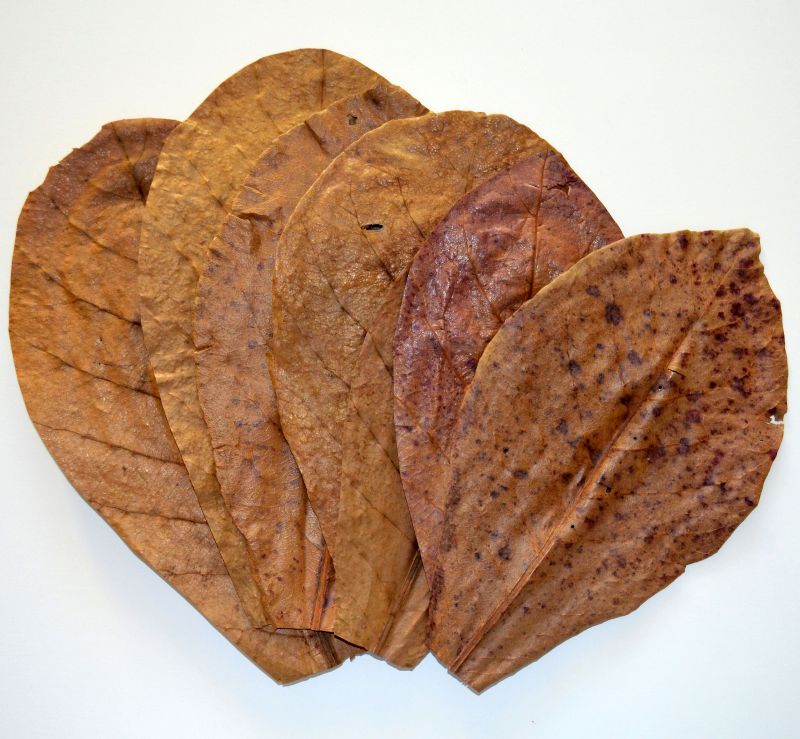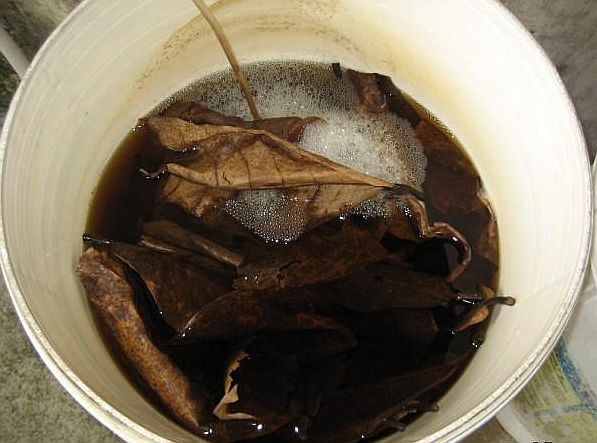Using Indian almond leaves for blackwater aquariums has been an easy, economical way to create the conditions necessary for keeping many types of sensitive South American tropical fish species.
For years, fish importers in southern Florida have been receiving boxes of fish from South American exporters that contained various species of dead leaves.
The reason exporters packed the leaves with some shipments was apparently for the medicinal properties that the leaves provided to the more sensitive species.
Indian Almond Leaves among several other types, do have special properties that leech out in the aquarium. Primarily the tannins that are released from the leaves.
The addition of dead leaves into a tank results in the release of humic substances that will lower the pH of the aquarium water.
These humic substances also act as an antibacterial and antifungal agent, and reduce the amount of heavy metals in the water.
Using Almond leaves for blackwater aquariums also provides a food source for some species, primarily the fry of many species.
Tanks littered with leaves on the bottom obviously have a positive effect on fish fry. The fry grow faster, larger, and happily appear to nibble on the decaying leaves.
The truth is that they are actually feeding on the “slime” that is created as the leaves are broken down by bacterial and fungal action.
Many South American blackwater habitats are characterized by large amounts of leaf litter, very low pH, and relatively few planktonic animals on which young fish can feed on.
Some fish species like Discus and uaru surmount this problem by excreting copious amounts of slime from their bodies for the fry to eat until they are able to fend for themselves.
As dead leaves are broken down by bacterial and fungal action, the slime produced seems to act as an alternative food source for fish that do not produce their own slime.
The survival rates of loricariid fry and many other species dramatically improve when leaves are present in the aquarium however, this could also be attributed to the increase in infusoria populations created by decaying leaves.
Using Almond Leaves for blackwater aquariums is not a new concept. Companies have been selling blackwater extract to tropical fish keeping enthusiasts for years as a “tonic” and as a cure for a variety of fish diseases. It has also been used to promote spawning in hard to breed species.
Some newcomers to tropical fish keeping recoil at the idea of placing leaves in an aquarium and letting them “rot”. The truth is that wild caught fish are much more likely to reside in areas with submerged decaying wood and plants than they encounter in an aquarium environment with sparkling clear, highly filtered water.
Most blackwater species seldom see the plants that they are housed with in an aquarium environment. The tannic acid in blackwater habitats makes the water extremely acidic and unsuitable for these type plants.
Discus, Angelfish, Apistogrammai spp., Uaru, Bettas, Badis and others benefit from bogwood, tree roots, and driftwood
in their tanks, so why not use other humic substance releasers, like the dead leaves found in their natural environments?
Almond leaves for blackwater aquariums are not the only type of leaf that can be used. Beach, red oak Q.rubra, European beech Fagus sylvatica, pendunculate oak Quercus robur, sessile oak Q. petraea, Turkey oak Q. cerris, hawthorn Crataegus monogyna and Japanese maple Acer palmatum have also been used with varying degrees of success. European Alder cones and Pine cones have also been used with some success. In short, it is reasonable to assume that as long as no poisonous tree species leaves are used, they should be aquarium safe when prepared correctly.
When collecting leaves, use only the leaves you can identify as being non-poisonous. Do not use live leaves from a tree, only use the leaves that have already dropped to the ground.
Autumn is a great time to collect freshly fallen leaves from deciduous trees. When the leaves fall to the ground, you can be sure there is no living tissue in them that could cause problems in the tank should they die.
Avoid collecting leaves that are near roadways or other areas that are possible sources of pollution. Do not use leaves that have bird droppings on them or are overly dirty.
When you have collected a sufficient amount, take them home and dry them out. When they are dried out you can store them for some time in a dry environment.
When you are ready to use them in your aquarium, do not boil them before use. Boiling sterilizes the leaves but also removes the beneficial qualities.
Instead, just soak the leaves in a 5 gallon bucket for a day or so.
They will float initially but will sink after becoming water logged.
Adding leaves to your tropical fish tank is a matter of trial and error. There are no set guidelines, so try adding a couple at a time.
Some species contain more tannins than others. The Indian Almond tree leaf contains more tannins than an oak leaf. The volume of water in your tank also determines the amount of leaves you need to use.
You may only need 4 or 5 Indian Almond Leaves leaves in a 55 gallon tank, but when using Beech or Oak leaves, you may need 10 or more to achieve the same desired effect.
Over a period of time the leaves will break down in your tank. It is not necessary to remove the broken down leaves from your aquarium. They will not harm your fish and when they are broken down altogether, you can just add more leaves.
Some leaves last longer than others. Indian Almond Leaves break down in three or four months, but Oak and Beech leaves will last at least twice as long.
Using almond leaves for blackwater aquariums is an economical, environmentally friendly way of keeping species that require soft, acidic conditions. Start with Indian Almond leaves and experiment with using some local species in your area.
A pocket tree guide might be of value.




3 Responses to “Almond Leaves For Blackwater Aquariums”
Trackbacks/Pingbacks
[…] almond leaves for blackwater aquariums, as well as Catappa leaves, is an economical way to provide Dwarf Rasboras and other delicate […]
[…] 6 or more specimens in a well established, dimly lit, densely planted aquarium with driftwood, dried Almond leaves and plenty of swimming space. They do well in a community tank with other small peaceful species […]
[…] fish keeping enthusiasts have been using Catappa, or Indian Almond Leaves for Blackwater aquariums and as a “poor mans water conditioner” for […]